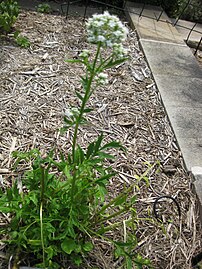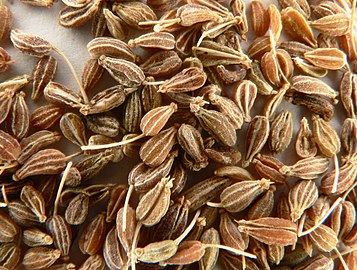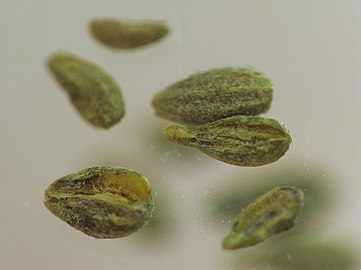Anise
| Anise | |
|---|---|
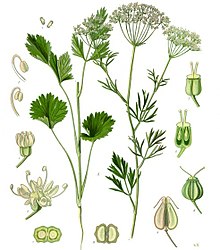
| |
| 1897 illustration[1] | |
| Scientific classification | |
| Kingdom: | Plantae |
| Clade: | Tracheophytes |
| Clade: | Angiosperms |
| Clade: | Eudicots |
| Clade: | Asterids |
| Order: | Apiales |
| Family: | Apiaceae |
| Genus: | Pimpinella |
| Species: | P. anisum
|
| Binomial name | |
| Pimpinella anisum | |
| Synonyms | |
|
Synonymy
| |
Anise(/ˈænɪs/;[3]Pimpinella anisum), also calledaniseedor rarelyanix,[4]is aflowering plantin the familyApiaceae[2]native to the easternMediterranean regionandSouthwest Asia.[5]
The flavor and aroma of its seeds have similarities with some other spices and herbs, such asstar anise,[4]fennel,licorice,andtarragon.It is widely cultivated and used to flavor food, candy, and alcoholic drinks, especially around theMediterranean.
Etymology
[edit]The name "anise" is derived viaOld Frenchfrom the Latin wordsanīsumoranēthumfrom Greekἄνηθονánēthonreferring todill.[6][7]
An obsolete English word for anise isanet,also coming fromanīsum.[8]
Botany
[edit]Anise is anherbaceousannual plantgrowing to 60–90 centimetres (2–3 feet) or more. Theleavesat the base of the plant are simple,1–5 cm (3⁄8–2 inches) long and shallowly lobed, while leaves higher on the stems are feathery or lacy,pinnate,divided into numerous smallleaflets.[9]
Both leaves and flowers are produced in large, loose clusters. Theflowersare either white or yellow, approximately3 millimetres (1⁄8in) in diameter, produced in denseumbels.
Thefruitis a dry oblong and curvedschizocarp,4–6 mm (1⁄6–1⁄4in) long, usually called "aniseed".[9][10]
-
Fruits in hand for scale
-
Fruits (aniseed)
-
Close-up of fruits
-
Cross-section of fruit
Ecology
[edit]Anise is a food plant for thelarvaeof someLepidopteraspecies (butterfliesandmoths), including thelime-speck pugandwormwood pug.[11]
Cultivation
[edit]Anise was first cultivated inEgyptand theMiddle East,and was brought toEuropefor its medicinal value.[12]It has been cultivated in Egypt for approximately 4,000 years.[13]
Anise plants grow best in light, fertile, well-drained soil. The seeds should be planted as soon as the ground warms up in spring. Because the plants have ataproot,they do not transplant well after being established so they should either be started in their final location or be transplanted while the seedlings are still small.[14]
Production
[edit]Western cuisines have long used anise to flavor dishes, drinks, and candies. The word is used for both the species of herb and itslicorice-like flavor. The most powerful flavor component of theessential oilof anise,anethole,is found in both anise and an unrelated spice indigenous toSouth China[15]called star anise (Illicium verum) widely used inSouth Asian,Southeast AsianandEast Asiandishes. Star anise is considerably less expensive to produce and has gradually displacedP. anisumin Western markets. While formerly produced in larger quantities, by 1999 world production of the essential oil of anise was only 8tons,compared to 400 tons of star anise.[16]
Uses
[edit]Composition
[edit]As with all spices, the composition of anise varies considerably with origin and cultivation method. These are typical values for the main constituents.[17]
- Moisture: 9–13%
- Protein: 18%
- Fatty oil: 8–23%
- Essential oil: 2–7%
- Starch: 5%
- N-free extract: 22–28%
- Crude fibre: 12–25%
In particular, the anise seeds products should also contain more than 0.2 milliliter volatile oil per 100 grams of spice.[18]
Culinary
[edit]
Anise is sweet andaromatic,distinguished by its characteristic flavor.[10]The seeds, whole or ground, are used for preparation ofteasandtisanes[19](alone or in combination with other aromatic herbs), as well many regional and ethnic confectioneries, including blackjelly beans(often marketed as licorice-flavored), Britishaniseed balls,aniseed twists[20]and "troach" drops, Australianhumbugs,New Zealand aniseed wheels, Italianpizzelleandbiscotti,GermanPfeffernüsseandSpringerle,AustrianAnisbögen,Dutchmuisjes,New MexicanbizcochitosandPeruvianpicarones.[citation needed]
The culinary uses of anise are not limited only to sweets and confections, as it is a key ingredient inMexicanatole de anísandchampurrado,which is similar tohot chocolate.[citation needed]InIndiaandPakistan,it is taken as adigestiveafter meals, used inbrinesin the Italian region ofApuliaand as a flavoring agent inItalian sausage,pepperoniand other Italian processed meat products.[21]The freshly chopped leaves are added to cheese spreads, dips or salads, while roots and stems impart a mild licorice flavor to soups and stews.[21]
Theancient Romansoften served spiced cakes with aniseed calledmustaceoeat the end of feasts as a digestive.[22]This tradition of serving cake at the end of festivities is the basis for the tradition of serving cake at weddings.[23]
Liquor
[edit]
Anise is used to flavor Greekouzoandmastika;[24]Italiansambuca;[24]Frenchabsinthe,anisette,[25]andpastis;[26]Spanishanis de chinchón,[27]anís,[28]anísado,[24]andHerbs de Majorca;[29]Turkish and Armenianrakı;[24]Lebanese, Egyptian, Syrian, Jordanian, Palestinian and Israeliarak;[24]and AlgerianAnisette Cristal.[24]Outside the Mediterranean region, it is found in Colombianaguardiente[25]and MexicanXtabentún.[30]These liquors are clear, but on addition of water become cloudy, a phenomenon known as theouzo effect.[31][32]
Anise is used together with other herbs and spices in someroot beers,such asVirgil'sin the United States.[33][34]
Traditional medicine
[edit]The main use of anise in traditional Europeanherbal medicinewas for itscarminativeeffect (reducingflatulence),[4]as noted byJohn Gerardin hisGreat Herball,an early encyclopedia of herbal medicine:
The seed wasteth and consumeth winde, and is good against belchings and upbraidings of the stomach, alaieth gripings of the belly, provoketh urine gently, maketh abundance of milke, and stirreth up bodily lust: it staieth the laske (diarrhea), and also the white flux (leukorrhea) in women.[35]
According toPliny the Elder,anise was used as a cure for sleeplessness, chewed withalexandersand a littlehoneyin the morning to freshen the breath, and, when mixed with wine, as a remedy foraspbites (N.H.20.72).[36]In 19th-century medicine, anise was prepared asaqua anisi( "Water of Anise" ) in doses of an ounce or more and asspiritus anisi( "Spirit of Anise" ) in doses of 5–20minims.[12]InTurkishfolk medicine, its seeds have been used as anappetitestimulant,tranquilizerordiuretic.[37]
Essential oil
[edit]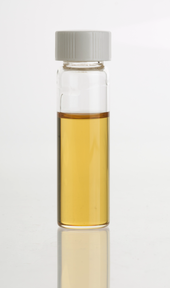
Aniseessential oilcan be obtained from the fruits by eithersteam distillationor extraction usingsupercritical carbon dioxide.[38]The yield of essential oil is influenced by the growing conditions[39]and extraction process, with supercritical extraction being more efficient.[38]Regardless of the method of isolation the main component of the oil isanethole(80–90%), with minor components including4-anisaldehyde,estragoleand pseudoisoeugenyl-2-methylbutyrates amongst others.[40](Alternately found by Orav et al. 2008 to be 2–6% extracted oil by weight of raw seed material, 74–94% beingtrans-anetholeand the remaining fractionestragole(methylchavicol),anisaldehydeandγ-himachalene.)[41]Anetholeis responsible for anise's characteristic odor and flavor.[42]
Other uses
[edit]Builders ofsteam locomotivesin Britain incorporated capsules of aniseed oil intowhite metalplain bearingsso the distinctive smell would give warning in case of overheating.[43]Anise can be made into a liquid scent and is used for bothdrag huntingandfishing.It is put onfishing luresto attractfish.[44][45]
References
[edit]- ^from Franz Eugen Köhlae, Köhlae's Medizinal-Pflanzen, 1897
- ^ab"Pimpinella anisumL. "World Flora Online.World Flora Consortium. 2023.Retrieved22 January2023.
- ^Wells, John C.(2008).Longman Pronunciation Dictionary(3rd ed.). Longman.ISBN978-1-4058-8118-0.
- ^abcBaynes 1878.
- ^"Anice vera,Pimpinella anisumL. "Flora Italiana.Altervista. n.d.
- ^Lewis, Charlton T.; Short, Charles (1879)."ănēthum".A Latin Dictionary.Perseus Digital Library.
- ^"Anise".Oxford Dictionaries, Oxford University Press. 2018. Archived fromthe originalon March 4, 2018.Retrieved3 March2018.
- ^"s.v.'anise'".
- ^abStephens, James M. (April 1997)."Anise—Pimpinella anisumL. "AskIFAS.University of FloridaInstitute of Food and Agricultural Sciences.Retrieved22 January2023.
- ^abKatzer, Gernot (9 September 1998)."Anise (Pimpinella anisumL.) ".Spice Pages.
- ^"Aniseed - Cargo Handbook - the world's largest cargo transport guidelines website".cargohandbook.Retrieved2022-05-25.
- ^abChisholm 1911.
- ^"Anise Uses, Benefits & Side Effects - Drugs Herbal Database".Drugs.Retrieved2022-05-25.
- ^"Tips for Transplanting Seedlings".Almanac.Retrieved2022-05-25.
- ^Peter, K. V. (2004).Handbook of Herbs and Spices.Woodhead Publishing. p. 290.ISBN978-1-85573-721-1.
- ^Philip R. Ashurst (1999).Food Flavorings.Springer. p. 33.ISBN978-0-8342-1621-1.[permanent dead link]
- ^J.S. Pruthi: Spices and Condiments, New Delhi: National Book Trust (1976), p. 19.
- ^Branch, Legislative Services."Consolidated federal laws of canada, Food and Drug Regulations".laws.justice.gc.ca.Retrieved2018-07-19.
- ^"Anise seed: Properties, benefits, mischief, dosage, and side effects".Alwosta.Archived fromthe originalon 2020-09-25.Retrieved2024-02-05.
- ^"Favourite traditional British sweets: in pictures".telegraph.co.uk.Retrieved2021-05-23.
- ^abPeter, K.V. (2012).Handbook of herbs and spices Volume 2.p. 143.
- ^"Anise History".Our Herb Garden.March 2013.Retrieved3 March2013.
- ^"Wedding Cake: A Slice of History | Carol Wilson".Gastronomica.2005-05-05.Retrieved2017-11-13.
- ^abcdefDealberto, Clara; Desrayaud, Lea (25 July 2017). "Le pastis, elixir provencal".Le Monde.Le Monde. p. 28.
- ^ab"16 Anise-Flavored Liquors".SenseList.2006-10-20.Retrieved13 November2017.
- ^Blocker, Jack S. Jr.; Fahey, David M.; Tyrrell, Ian R. (2003).Alcohol and Temperance in Modern History: An International Encyclopedia.ABC-CLIO. pp. 478–.ISBN978-1-57607-833-4.Retrieved28 March2013.
- ^admin."Chincon".Chincon(in Spanish).Retrieved2022-11-06.
- ^Zurdo, David; Gutiérrez, Ángel (2004).El libro de los licores de España.Ediciones Robinbook. p. 50.ISBN9788496054127.Retrieved5 February2013.
- ^"Majorcan herb liqueur in Spain".Spain.info.2007-04-23.Retrieved22 January2018.
- ^"Xtabentún Cocktail Guide, with Origins and Recipes".Wine Enthusiast Magazine.29 February 2012. Archived fromthe originalon 27 November 2022.Retrieved13 November2017.
- ^Sitnikova, Natalia L.; Sprik, Rudolf; Wegdam, Gerard; Eiser, Erika (2005). "Spontaneously Formed trans-Anethol/Water/Alcohol Emulsions: Mechanism of Formation and Stability".Langmuir.21(16): 7083–7089.doi:10.1021/la046816l.PMID16042427.
- ^Ganachaud, François; Katz, Joseph L. (2005). "Nanoparticles and Nanocapsules Created Using the Ouzo Effect: Spontaneous Emulsification as an Alternative to Ultrasonic and High-Shear Devices".ChemPhysChem.6(2): 209–216.doi:10.1002/cphc.200400527.PMID15751338.
- ^"Virgil's Bavarian Nutmeg".Reeds. Archived fromthe originalon April 21, 2014.RetrievedMay 12,2014.
- ^"Virgil's Rootbeer – Spike's Root Beer Reviews and Ratings".Root Beer Reviews.RetrievedMay 12,2014.
- ^John Gerard,The Herball, or Generall Historie of PlantesArchived2011-06-14 at theWayback Machine,1597, p. 880, side 903
- ^Pliny (1856). "Book XX. Anise—sixty-one remedies".The Natural History of Pliny.Vol. 4. translators John Bostock, Henry Riley. London: Henry Bohn. pp. 271–274.OCLC504358830.
- ^Baytop, T. (1999)Therapy with medicinal plants in Turkey, Past and Present.Kitapevi, Istanbul, Turkey, 2nd edition, pp. 142.
- ^abPereira, Camila G.; Meireles, M. Angela A. (September 2007). "Economic analysis of rosemary, fennel and anise essential oils obtained by supercritical fluid extraction".Flavour and Fragrance Journal.22(5): 407–413.doi:10.1002/ffj.1813.
- ^Zehtab-salmasi, S.; Javanshir, A.; Omidbaigi, R.; Alyari, H.; Ghassemi-golezani, K. (May 2001)."Effects of water supply and sowing date on performance and essential oil production of anise (Pimpinella anisumL.) ".Acta Agronomica Hungarica.49(1): 75–81.doi:10.1556/AAgr.49.2001.1.9.
- ^Rodrigues, Vera M.; Rosa, Paulo T. V.; Marques, Marcia O. M.; Petenate, Ademir J.; Meireles, M. Angela A. (March 2003). "Supercritical Extraction of Essential Oil from Aniseed using sCO2:Solubility, Kinetics and Composition Data ".Journal of Agricultural and Food Chemistry.51(6): 1518–1523.doi:10.1021/jf0257493.PMID12617576.
- ^Sayed-Ahmad, Bouchra; Talou, Thierry; Saad, Zeinab; Hijazi, Akram; Merah, Othmane (2017)."The Apiaceae: Ethnomedicinal family as source for industrial uses"(PDF).Industrial Crops and Products.109.Elsevier:661–671.doi:10.1016/j.indcrop.2017.09.027.ISSN0926-6690.
- ^Jodral, Manuel Miro.Illicium, Pimpinella and Foeniculum.CRC Press, 2004. pp. 205
- ^The Railway Magazine.99:287. 1953.
{{cite journal}}:CS1 maint: untitled periodical (link) - ^Collins, Tony (2005).Encyclopedia of traditional British rural sports.Abingdon, England: Routledge. p. 140.ISBN978-0-415-35224-6.
- ^Gabriel, Otto; von Brandt, Andres (2005).Fish catching methods of the world(4 ed.). Oxford, England: Blackwell. pp. 153–4.ISBN978-0-85238-280-6.
Further reading
[edit]- Baynes, T. S., ed. (1878),,Encyclopædia Britannica,vol. 2 (9th ed.), New York: Charles Scribner's Sons, pp. 57–58
- Chisholm, Hugh,ed. (1911),,Encyclopædia Britannica,vol. 2 (11th ed.), Cambridge University Press, p. 55

